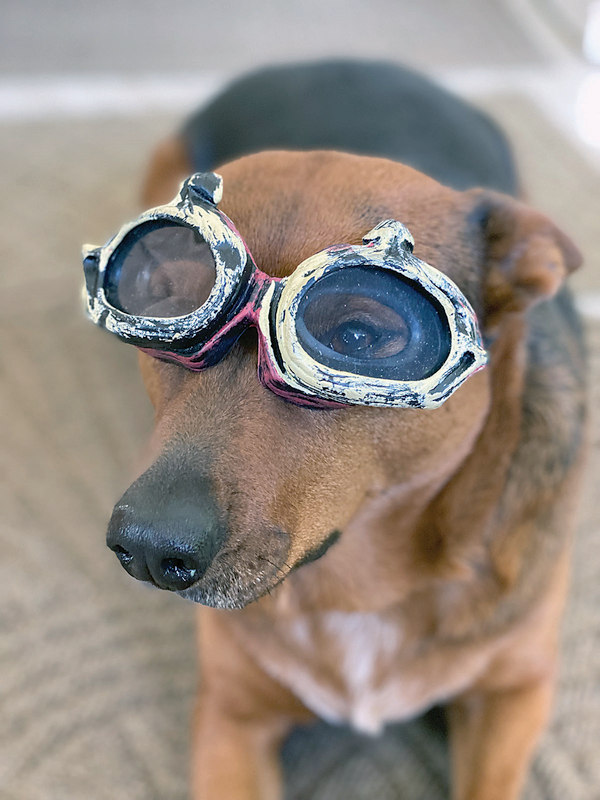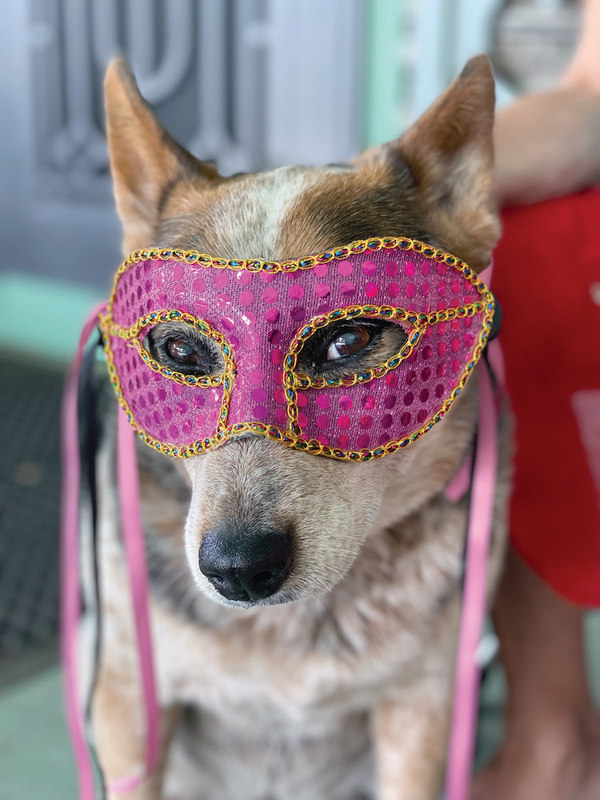Story & photos by Shari King
With cooler temperatures, longer nights, and the arrival of fallen leaves crunching at one’s feet, we all start to anticipate the wonderful gifts of fall. Fall festivals, fall decorations, and of course the super-fun holiday Halloween. But for some of our four-legged friends, All Hallows Eve can become a dreadful time especially if it precludes an emergency trip to the vet. Even more horrifying, hospitalization in an animal hospital, the scariest place on the planet for some pets.

Let’s take a look at some common preventable Halloween hazards.
The most common hazard: accidental poisoning. Here is a fright-filled list of the potential poisonous substances our pets encounter each Halloween.
Chocolate
Not a surprise entry into our ghoulish list of deadly poisons but a very clear runner for top dog. Dogs are sensitive to the chemicals theobromine and caffeine in chocolate. These gruesome chemicals are present in products made from cocoa.
Dark chocolates contain much larger amounts of these toxic chemicals than milk chocolate. Dogs metabolize theobromine and caffeine much slower than you or I. This can affect the stomach, the nervous system, the heart, and can seriously impact a dog’s kidney function.
One of the first signs of chocolate toxicity dog owners may see is vomiting and diarrhea. This can occur a mere 2-4 hours after ingestion. If you come home from the neighborhood block party and find remnants of torn chocolate packaging, and you’re sure that your dog has consumed dark chocolate, you can induce vomiting if it has been within a 1-2 hour window. But longer than that, the stomach empties and the theobromine and caffeine are already being absorbed by the intestines.
Advanced stages of chocolate toxicity will present restlessness, anxiety, stiffness, and possibly seizures. Unfortunately, if they get to this stage, many dogs, if they are not treated, will die within 48 hours.
Pet owners need to be aware that there are other sources of chocolate and caffeine that aren’t necessarily made by common commercial chocolate companies. There are some types of mulch that contain cocoa beans hulls, so dog owners need to be careful about what types of mulch they spread in their gardens. This can also be harmful to horses and chickens, too.
Xylitol
A relatively newcomer in the world of pet toxins, xylitol is a sugar substitute found in sugar free gums, mints, and candies. Some companies are also using it in peanut butters, so always be sure to check the labels!
When dogs eat something containing xylitol, it is quickly absorbed into the bloodstream and can result in a rapid release of insulin and decrease in blood sugar. This can occur within 10 to 60 minutes of consuming a food containing xylitol.
Left untreated, the sweet treat can quickly become life-threatening. If your dog ingests xylitol, it is important to find the packaging for the product so that the amount of xylitol consumed can be estimated by poison control.
Raisins and Grapes
Not the most life threatening of all our poisonous participants; however, the price tag of the vet visit for IV fluids, blood work, and hospitalization may just put you into cardiac arrest from sticker shock.
The most common early symptoms of grape or raisin toxicity is vomiting. This is generally seen within 24 hours following ingestion. Lack of appetite, lethargy, and possibly diarrhea can be also seen within the next 12-24 hours. The more severe signs are typically not seen for up to 24-48 hours after ingestion. Unfortunately, these signs are often noted after acute kidney damage has already begun.
Symptoms of acute kidney failure include nausea, lack of appetite, vomiting, diarrhea, abdominal pain, excessive thirst, and excessive urination. As poisoning progresses, the kidneys will stop functioning, and the dog may not be able to produce urine.
The dog’s blood pressure often increases dramatically. He or she may lapse into a coma due to a buildup of substances which the kidneys usually eliminate through urine. Once the kidneys have shut down and urine output has dropped, the prognosis or outcome is usually poor.
Rotting Pumpkins
Not a well-known poison in pets, but certainly worth mentioning. Mycotoxins are poisonous substances produced by fungi and molds that grow on spoiled food. These substances are toxic to dogs.
Dogs and cats eat pumpkin readily, but if that Jack O’ Lantern on the front porch is starting to sag and develop mold, it may be time to give it the ole heave ho before some furry friend decides to snack on it.
The next contender on our Halloween hazardous horror list is choking.
Lollipops on Sticks
How many licks does it take to get to the middle of a Tootsie pop? Many large dogs don’t even give you a chance to start counting, and it’s gone!
Unfortunately, choking is a life threatening emergency that has to be handled immediately. Rarely is there ever time to make the phone calls, and the trip to the vet in order to safe a pet’s life from choking. You can perform the Heimlich Maneuver on your pet if you’re present when ingestion occurs.
There are excellent videos online displaying the proper way to perform the Heimlich maneuver on a pet. Familiarize yourself with the technique by watching several of these videos before tragedy strikes so you can act quickly and confidently.
When a dog is choking and oxygen is cut off to his brain and circulatory system, he will instinctively start to panic. This can make even the calmest of dogs exhibit out-of-control behavior.
If your dog is panicking, try to keep him restrained so he doesn’t hurt you or himself. Wrapping a blanket around him helps but don’t restrict his ability to move his mouth.
Costume Parts
Costumes on pets are so adorable! However loose parts, googly eyes, pom-pom noses, tassels, and buttons are all choking hazards.
Never leave your pet unattended while he is dressed like a cowboy, monkey, or taco. Leaving decorative Halloween collars on cats is also a definite no-no.

Halloween Decorations
Pretty, bright colors, sparkles, and glitter are looking oh, so tasty to your Bulldog, Bubba.
Do your best to decorate your space in a pet friendly way. Keep the ingestible Halloween deco off the coffee table, the windowsills, and the stairs. Counter height and above is generally safe unless you share your home with a Great Dane.
Glow Sticks
These are very alluring to dogs that like to chew, and although the chemical dibutyl phthalate is generally nontoxic, it can cause problems.
When a dog bites into or ingests glow jewelry or glow sticks, the chemical causes an intense taste reaction. Symptoms can include drooling and pawing at the mouth from skin irritation. Vomiting is rare. The biggest threat from eating glow sticks is primarily from choking or possible bowel obstruction from the chewed pieces of plastic.
Burns
Not a common occurrence in our (thankfully) wildfire-conscious state, but it happens. Who doesn’t love the scent of a pumpkin spice or candy-corn candle? So do dogs, and if it smells good, it must taste good, right?
Be sure you never leave a candle burning unattended around pets, and displaying a candle higher is always better.
The Lost Pet
This is surely the most dreadful of Halloween hazards.
Losing a pet is a very common occurrence during the hustle and bustle of any holiday. The door opens and closes often, and we become distracted. Unfortunately, animals are curious and most definitely, opportunists.
If the possibility of trick or treating happens for us this year (keep your fingers crossed), it’s always best to secure pets in a back room or bedroom.
If you have an anxious, spooked pet, try your best to limit the sound of the doorbell or door knocking. Perhaps set up a lawn chair outside for yourself in a scary costume with your goodies? Enjoy hand delivering the trick or treats to all the monsters, superheroes, and fairies hopefully prowling your neighborhood this Halloween.
So while you are stringing cobwebs and filling that plastic pumpkin with treats, take a moment to locate the phone number of emergency animal hospital nearest you and keep it handy. Load it into your phone while you have a clear head. Include the number for Poison Control too. The ASPCA Poison Control number is 888-426-4435.
With a dog’s weight, the packaging of the poisonous product, and the amount consumed, they can help calculate whether a pet is in trouble and also teach you how to induce vomiting if needed. It may just save your dog’s life.
Hoping you and your pets have a safe and happy Halloween!

